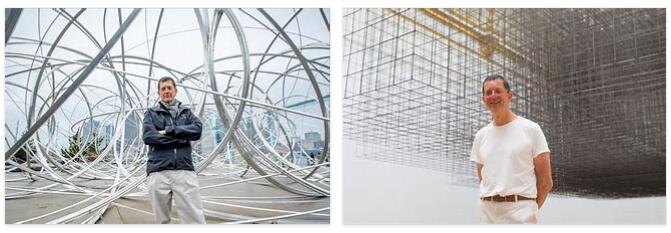
Hans Holbein (1497 – 1543)
The Augsburg-born painter went to London in 1526, where he portrayed many members of the royal family. In the course of time he had numerous students; his portrait of Duchess Christina of Milan is in the National Gallery.
Peter Paul Rubens (1577 – 1640)
Rubens lived in the English capital during the Baroque period. Between 1635 and 1636 he created the ceiling painting in the Banqueting Haud, which depicts the life story of King James I.
Anthonis Van Dyck (1599 – 1641)
The Dutchman went to London in 1632, where he lived in the Blackfriars district. He is considered the founder of the English school of painting, which made the aristocratic portrait an art form. His work is divided into three creative periods: the Flemish epoch, the Genoese epoch and the painter’s English-influenced style, which can be traced in the National Gallery.
Sir Peter Lely (1618 – 1680)
The Dutch artist lived in England from 1641 and experienced the Reformation phase, in which the visual arts briefly lost importance due to the dissolution of the monasteries. After the political restoration under Charles II, he worked as a court painter; many of his works can be viewed in the National Portrait Gallery.
William Hogarth (1697 – 1764)
The London-born silversmith and copper engraver is now considered a revolutionary in the visual arts: the aristocratic portrait had lost its content; Hogarth drew simple people, landscapes and social scenes. He was appointed to court in 1757 and the National Gallery is showing 16 of his works.
Sir Joshua Reynolds (1723-1792)
The second great revolutionary in painting after William Hogarth, was appointed first President of the newly founded Royal Academy in 1768. He was considered a great promoter of hidden talents. His work is now in the National Gallery and the Wallace Collection.
John Mallord William Turner (1775-1851) is considered one of the world’s finest landscape painters. When Turner was 15 years old, one of his works was exhibited at the Royal Academy. Although he became famous for his oil paintings, he would later become one of the founders of English watercolor painting. Some of his most famous images are Calais Pier, Dido Building Carthage, Rain, Burial at Sea, The Grand Canal, and Venice.
Barbara Hepworth (1903-1975) was one of the leading abstract sculptors of her time and, along with Ben Nicholson, part of the Cornwall-based artist group St Ives.
Francis Bacon (1909 – 1992) was a painter of Anglo-Irish descent whose abstract works of art are reminiscent of grotesque, nightmare-like worlds through their figures, deformed in strong colors. Bacon was a distant relative of the philosopher Bacon.
Thomas Gainsborough (1727-1788) was a Suffolk English painter. Originally trained as a landscape painter, he became known for his imaginative and colorful portraits of the royal family and the English nobility.
Damian Hirst (born 1965)
The Leeds born artist is one of the main representatives of the generation of “Young British Artists”, which also includes Tracy Emin (Turner Prize 1999) and the Chapman Brothers. His trademark is dealing with medicine and the social environment. Quasi-scientific experiments show glazed containers with sharks, cows and pigs cut in half, and shocked critics and British audiences alike in the 1990s.
Rachel Whiteread (born 1963) from London is an artist from the generation of “Young British Artists”. Her sculptures, mainly concerned with realistic plastic replicas, are very present in Great Britain. The young artist is also developing an important role in the international scene, for example through the replica of the interior of a library commissioned in 2000 for Vienna’s Judenplatz.
Athony Gormley (born 1950) is best known for his huge steel sculpture “Angel of the North” in Gateshead in North West England. Other important works, which also deal with the body and the context of the environment, are laid out in large spaces and mostly outdoors, such as his work “Field”. Gormley received the Turner Prize in 1994 and the South Bank Prize in 1999.
The artist duo Gilbert (born 1943) & George (born 1942) stand for anti-elitism and the “art for everyone” movement in Great Britain in the 1960s and 1970s. Their establishment in the then still simple working-class Spitalfields district in London’s East End has given the entire district its current dense infrastructure of galleries and artists. Her work is varied, but mostly deals with the media of photography and film in combination with colorful pop painting. The work of the two artists has been exhibited continuously in the most important international art houses since 1969. You were awarded the Turner Prize in 1987.
Architects and builders
John Nash (1752 – 1835)
The architect designed the London “Royal Route” at the beginning of the 19th century, which ran from the Royal Palace, to Pall Mall via Piccadilly Circus, Regent Street and Regent’s Park with numerous elegant neoclassical mansions such as B. Park Crescent. Nash also built Buckingham Palace and the Theater Royal Haymarket, among others.
Inigo Jones (1573 – 1652)
the chief city planner of London revolutionized the architecture of London with stylistic elements of the Italian Palladio. His works include St. Paul’s Church, Covent Garden and The Queen’s House.
Sir Christopher Wren (1632-1723)
After the Great Fire of London in 1966, the royal town planner was tasked with rebuilding the entire city. The plan he had drafted failed due to funding, but Wren had 51 of the 107 destroyed churches restored, including St Mary-le-Bow, Cheapside and St Bride’s. His masterpiece is St. Paul’s Cathedral.
Robert Adam (1728 – 1792) was Scotland’s most famous architect and known for his decorative detail work on stately homes and castles such as Culzean Castle in the Scottish lowlands.